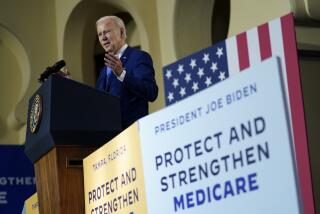Why the website meltdown won’t crash Obamacare
- Share via
The crash of the Obamacare federal website, which is preventing many people in three dozen states from signing up for health insurance, has turned the outright hate some conservatives have for the program all of a sudden into sympathy and solicitude.
Here’s Bloomberg’s house libertarian Megan McArdle, who normally has nothing nice to say about the Affordable Care Act, arguing that if the website isn’t fixed by mid-November, the system faces a “death spiral”--only sicker and older applicants really desperate for coverage will sign up, and healthy youngsters will blow it off.
She writes disingenuously, as if more in sorrow than anger: “That’s the time when it absolutely has to work--and if it doesn’t, we should panic.”
The “death spiral,” technically known as adverse selection, has become the go-to concern of Obamacare critics. The idea is that if insurers end up with a preponderance of sick, costly customers, they’ll raise premiums, which will further discourage young invincibles from buying insurance, which will make policies even more expensive for those who do buy, and on and on and on.
But the critics should relax, as should Obamacare supporters who fear the same thing. As Adrianna McIntyre of the University of Michigan points out, the Affordable Care Act has a corrective to the “death spiral” built in. It’s known as “risk adjustment.” As McIntyre observes, its “entire purpose is to stabilize premiums during the first three years of Obamacare, when it’s especially difficult for insurers to price plans.”
Risk adjustment works by compensating insurance companies for the costs of adverse selection. The insurers start by declaring the target cost for 2014. If their costs come in more than 3% over that target, the government will pay them 50% of the excess; if the costs are 8% or more above projections, they’ll get back 80% of that excess cost.
The system works in reverse too--if the insurers have overestimated their costs, they’ll have to remit a portion of their excess profit back to the government.
The system obviously won’t cover the entire cost of adverse selection. And if the delay in fixing healthcare.gov persists through the end of this year and into the next--or if it prompts the government to waive individual penalties that would otherwise kick in on April 1--the risk bailout may become a cost to the Treasury (although McIntyre notes that the expense will be moderated by the lower expenses of premium subsidies required if eligible applicants don’t sign up). But it will eliminate the “death spiral.”
More to Read
Inside the business of entertainment
The Wide Shot brings you news, analysis and insights on everything from streaming wars to production — and what it all means for the future.
You may occasionally receive promotional content from the Los Angeles Times.











